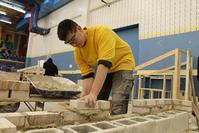Does an “equal” education promote inequality?
Could it be that preparing all children for college, as most schools do today, is worse for most students than a non-academic, practical life skills education? Academics may want to consult deceased rapper Tupac Shakur, who felt traditional education failed him.
Academics have long debated whether kids are best served by “educational equality,” in which everyone’s taught the same things in preparation for college, or “educational adequacy,” where kids are taught differently based on interests and life circumstances. In a rather startling video filmed in 1988, when he was 17, Tupac argues that the traditional liberal arts model of education failed to engage him and other students from disadvantaged backgrounds.
While Tupac concedes that skill development is important, he argues that kids in his working-class neighborhood can’t draw connections between what they learn in school and what they experience outside of it. Feeling that school isn’t relevant to them, they drop out of school in favor of activities that may be of immediate use, even if they are self-destructive in the long term.
“I think we got so caught up in school being a tradition that we stopped using it as a learning tool,” he says. Instead, he notes, “the streets have taught me.”
Tupac instead suggests classes on drugs, “real” sex education, race and class in America, and media literacy. He feels they would engage students and provide them content that they need from day to day. Many of these subjects are impractical for the school system to develop, running afoul of calls for political and religious neutrality. But Tupac offers a broader lesson here that should be addressed: education must be continuously “sold” to the student, and different consumers need and want different things.
College prep poorly serves most high school students
The equality-versus-adequacy debate focuses on a very abstract social justice question: don’t children who probability suggests won’t complete a traditional four year post-secondary degree deserve the chance to try? Posed that way, the answer can only be yes, which in turn shapes the educational options provided to our students.
While most jurisdictions make a half-hearted effort at vocational education, teaching a few percent of their student body marketable blue-collar skills, virtually none make that an easy, practical, and desirable option for most students. The programs are under-funded, often unavailable at one’s local school, and stigmatized by other students and administrators alike.
We must realize that only 32% of young adults complete an undergraduate degree by 29, meaning the vast majority of high school students need preparation for a decade or more of life without any further education. They may not benefit from learning about the development of constitutional norms, the Senate confirmation process, or calculus.
Instead, these students need to learn what protections are afforded to them by employment laws. They need classes that prepare them to navigate government programs, secure employment, understand the contracts they sign, nurture relationships and build a family. They need to be taught about the structure of the US workforce, and what the requirements are on paper and in practice to advance in different industries. They need to be taught consumer financial skills.
Opposition to this sort of divided curriculum predictably describe this approach as elitist, and discuss the role of public education in encouraging social mobility. This is the dark side of the American Dream: most students will not be able to significantly change their socioeconomic class, but that shouldn’t mean they receive an education whose objectives ignore them.
Is it defeatist to accept a stratified society, or naïve to assume otherwise?
If children are indeed prepared by their parents from infancy in ways that often differ based on socioeconomic class, should they be taught differently when they enter the school system? If those differences increase over time due to influences outside of school, should the school system provide opportunities that challenge each child in level appropriate to their personal needs?
Should schools teach them skills relevant to the probable course of their lives, even if this means a wider and wider spread between the pedagogy of the professional class, and the pedagogy of the poor?
The twin goals of the public school system are adequacy and equality. We want schools that teach all students enough for them to live meaningful lives of dignity in a world that demands more from all of us every year. More than that, we want schools that give each child the best education they can use. At the same time, we want schools that give children from all backgrounds an equal set of opportunities to pursue their dreams.
These goals are in conflict, and we’ll never be able to achieve them all.
To suppress inequality, we have tried to provide remedial education as a substitute for advantages wealthy children acquire at home, while pointing each child at a college track that maybe 50% of them will ever follow. In the process, we have lost many students who give up on schooling that seems entirely unrelated to their lives and circumstances.
Giving each student the curriculum best suited for their level of preparation and eventual path in life will entrench society’s stratification. Nevertheless, by giving more attention to and validating non-college prep coursework, we will at least prepare these children for the paths they will probably follow. All we give up is the hope of using schools to heal our society’s injustices.

